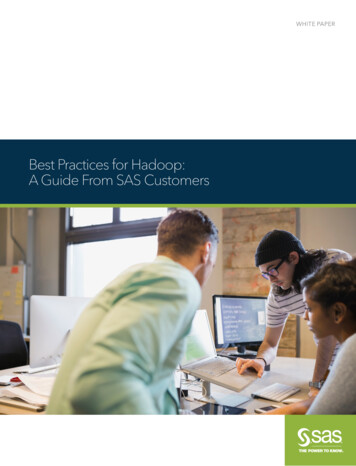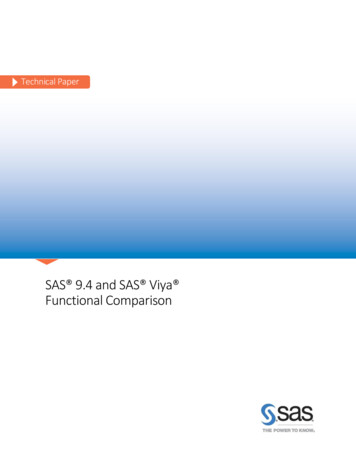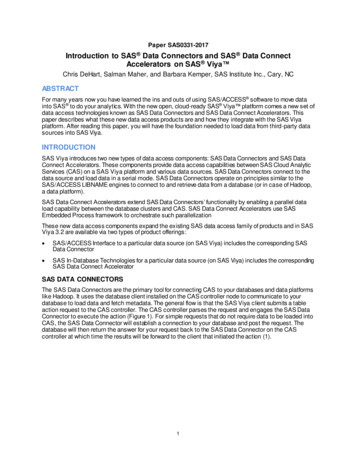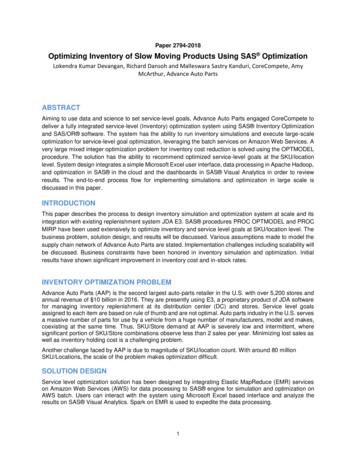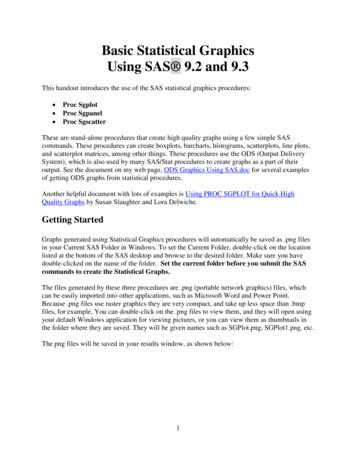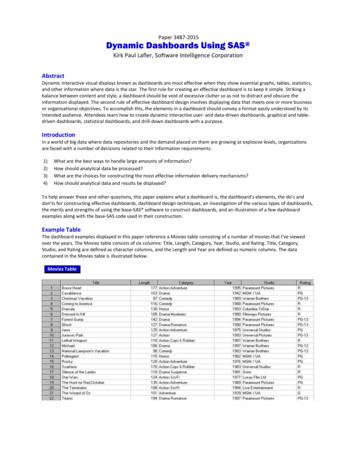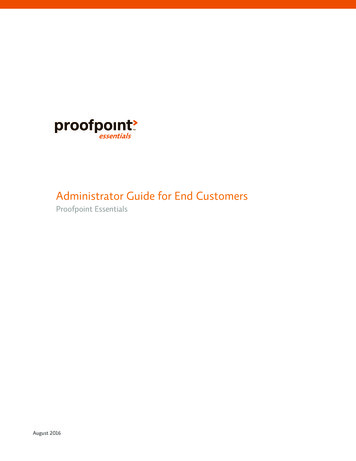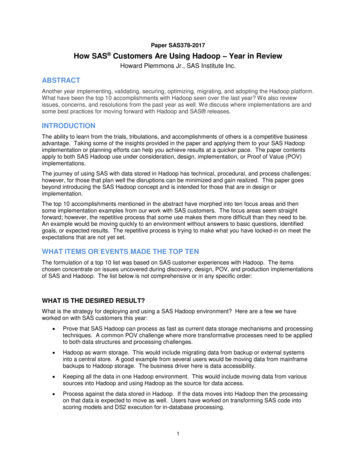
Transcription
Paper SAS378-2017How SAS Customers Are Using Hadoop – Year in ReviewHoward Plemmons Jr., SAS Institute Inc.ABSTRACTAnother year implementing, validating, securing, optimizing, migrating, and adopting the Hadoop platform.What have been the top 10 accomplishments with Hadoop seen over the last year? We also reviewissues, concerns, and resolutions from the past year as well. We discuss where implementations are andsome best practices for moving forward with Hadoop and SAS releases.INTRODUCTIONThe ability to learn from the trials, tribulations, and accomplishments of others is a competitive businessadvantage. Taking some of the insights provided in the paper and applying them to your SAS Hadoopimplementation or planning efforts can help you achieve results at a quicker pace. The paper contentsapply to both SAS Hadoop use under consideration, design, implementation, or Proof of Value (POV)implementations.The journey of using SAS with data stored in Hadoop has technical, procedural, and process challenges;however, for those that plan well the disruptions can be minimized and gain realized. This paper goesbeyond introducing the SAS Hadoop concept and is intended for those that are in design orimplementation.The top 10 accomplishments mentioned in the abstract have morphed into ten focus areas and thensome implementation examples from our work with SAS customers. The focus areas seem straightforward; however, the repetitive process that some use makes them more difficult than they need to be.An example would be moving quickly to an environment without answers to basic questions, identifiedgoals, or expected results. The repetitive process is trying to make what you have locked-in on meet theexpectations that are not yet set.WHAT ITEMS OR EVENTS MADE THE TOP TENThe formulation of a top 10 list was based on SAS customer experiences with Hadoop. The itemschosen concentrate on issues uncovered during discovery, design, POV, and production implementationsof SAS and Hadoop. The list below is not comprehensive or in any specific order:WHAT IS THE DESIRED RESULT?What is the strategy for deploying and using a SAS Hadoop environment? Here are a few we haveworked on with SAS customers this year: Prove that SAS Hadoop can process as fast as current data storage mechanisms and processingtechniques. A common POV challenge where more transformative processes need to be appliedto both data structures and processing challenges. Hadoop as warm storage. This would include migrating data from backup or external systemsinto a central store. A good example from several users would be moving data from mainframebackups to Hadoop storage. The business driver here is data accessibility. Keeping all the data in one Hadoop environment. This would include moving data from varioussources into Hadoop and using Hadoop as the source for data access. Process against the data stored in Hadoop. If the data moves into Hadoop then the processingon that data is expected to move as well. Users have worked on transforming SAS code intoscoring models and DS2 execution for in-database processing.1
Cost savings. Some have started the Hadoop expecting overall cost savings over current datastorage and access methods. Many have found that true savings is obtained through the resultsobtained using data stored in Hadoop. Realizing the disruptive benefit of being able to get analytically ahead of the competition.SOLIDIFY SUPPORT AND ENGAGE ACTIVE PARTICIPANTSWe have seen that under supported or under staffed Hadoop projects have a high probability of delay orfailure. Here are some team concepts that have been effective:1. You need executive sponsorship and you need to have technical sponsorship/leadership. Thetechnical lead should be at a level in the organization to engage with either IT or the business unitas contributors to the decision making capacity.2. You need time commitments from the end-user community who have a vested interest in SASHadoop implementation. These users should understand their data and have a goodunderstanding of how SAS interacts with the data you intend to put into Hadoop.3. Set the vision, develop the plan, assign tasks, and create a timeline based on success criteria.You need to put some structure around your punch list to avoid inevitable scope creep.DATA ASSESSMENT AND MAPPINGData assessment and mapping might be one of the least funded and most problematic issues withHadoop. The investment of time to develop a comprehensive data strategy when using Hadoop iscritical. Some of these questions and strategies have helped in the data identification and ingestionprocess:1. Are you planning on loading SAS data into Hadoop? If so, consider the following example:a) Is a 10 numeric column, 500K row SAS data set big data? For Hadoop, the answer is no.Your SAS data set, which is 40M in size will be represented as a single data split in theHadoop environment. What this means is single threaded processing on one piece of data inHadoop. Given this fact, your SAS process running against this SAS data set is the bestperformer. Note that Hadoop data splits are 128M and up; therefore, your SAS data set inHadoop should be many multiples of the data split size before considering Hadoop for datastorage and processing.b) How do you plan on processing the SAS data you have loaded into Hadoop? If the processis read-only, evaluate the type of Hive table you have created. This would include columntypes, Hadoop storage format, and access patterns.2. Are you planning on loading data from a DBMS into Hadoop? If so, and if the DBMS uses acomplex data model, consider how Hadoop is going to interact with that model. Withoutconsideration, your ability to port and efficiently process using HiveQL might not work. If that isthe case, then converting the data model into one that can be processed in Hadoop might benecessary. How you map the needed data should mirror the processes you plan to run on it.3. Data cleansing should be part of your assessment. As you load data from external data sourcesinto Hadoop consider adding cleansing operations as part of the process. With Hadoop, you willfind it is much easier to cleanse on the way in rather than trying to change data in place.4. How are you planning to refresh the data you are loading? Incremental refreshes might be difficultto implement given that Hadoop has yet to become fully ACID complaint.5. How are you planning to access the data in Hadoop? Hadoop is at his best when data isprocessed in large chunks as opposed to individual records. With the latter scenario, Hadoopmight simply prove not to be the ideal platform for your organization.2
6. What type of storage format are you planning on using for your Hadoop data? While widely used,text might not be the best option from a performance standpoint. If your organization plans onaccessing the same data using components such as Hive and Impala at the same time, ORCmight be a more sensible choice. If Impala is your only data access tool, Parquet might providethe best performance.7. Are you planning on compressing your data on Hadoop? Currently several compression optionsare available. Evaluate pros and cons of each one based on your needs before making a finaldecision. Also remember that some storage formats like ORC already have compression built-in,which might ease the decision-making process.8. How are you planning to secure your data? By default, Hadoop is a non-secure environment, buton the other hand, too much security can pose performance issues (KNOX, for example).9. What about encryption zone? Do you plan on creating pockets of data to specific users ordivisions within your organization?10. Do you plan on implementing a data archival process to phase out old data while ingesting newone? Where will the old data be archived? How “old” is old?11. Have you thought on how to handle disaster recovery scenarios? Can your Hadoop data pool berebuilt using other data sources? If not, do you have a backup/recovery strategy in place?INFRASTRUCTURE INVESTMENTWe see two parallel tracks on investing and tracking infrastructure investment. The first is hardware,networking bandwidth, software, and adherence to your internal protocols that govern these areas. Thesecond is the expertise that is needed to implement and maintain a SAS Hadoop environment.Dedicated access to these experts and administrators can have a positive impact on your implementationtimeline. This administration expertise includes:1. SAS Administrator – one who understands SAS system requirements for Hadoop, SAS metadata,SAS in-database, SAS/ACCESS, performance, and tuning.2. Hadoop Administrator – one who understands Hadoop security, SQL, Hadoop clusterperformance, tuning and monitoring.3. Network/Security Expertise – one who can assist in user security concerns and configurations asa precursor to enabling security in Hadoop. Some of the items would include Kerberos,interaction between users and Hadoop, security guidance for establishing Hadoop best practices,help with Kerberos ticket generation or troubleshooting.4. Hardware/OS Expertise – one who can help with UNIX or Linux issues, options, installation, andOS patches to meet both SAS and Hadoop system requirements.5. Technical Project Manager (PM) – one who can provide end-user technical leadership, whichwould include securing resources 1-4 and end-user support. We have seen increased successwhen the PM has a greater understanding of the data and processing goals.END-USER IDENTIFICATION AND ONBOARDINGTo be successful the procedure and process of both identifying members of the user community andproviding them access to the Hadoop environment is critical. Identification and onboarding processesneed to be in place ahead of time. You might find some of these practices helpful:1. Identification of the end user also means identifying the data that they will need in Hadoop. Thisdata might contain data stored in SAS data sets, RDBMS, and other data storage locations. Wehave helped with programmatic assessments that identify data usage rather than requiring endusers to provide the data details.3
2. Once you have data identified, you must create a secure environment within the Hadoopecosystem. We have seen concerns with security with data fields, data at rest and extracted datafrom the Hadoop environment. Having a detailed plan and implementers before onboarding endusers or end-user data will save time.END-USER EDUCATION AND TRAININGWe have seen several scenarios used for end-user training. Some of these have had different levels ofreturn for their Hadoop implementations:1. Functional training for experienced SAS programmers whose data is moving to Hadoop.Deciding when to provide training and best practices for the user community should be on yourtimeline. We have seen good success when the training is followed with execution against thenew environment. Training with a large gap between the education process and executionprovided diminished returns in some cases.2. Best practices developed for end users as part of the education process was shown to be veryeffective. These practices include SQL optimization, SAS execution strategies, and codingefficiencies specific to end-user environments. We have seen good results injecting bestpractices into end-user executions against SAS Hadoop environments.3. Peer-to-peer training has been proven effective in the knowledge transfer (KT) process. In thisscenario, a group of power users experiments with implementations in Hadoop. Theseexperiments would result in best practices and/or mentoring for other end-users within the samedepartment or organization.DATA MIGRATIONThis critical step has been problematic for many in 2016. We have seen unsuccessful first attempts toingest data into Hadoop. It is not that you can’t load data into Hadoop; it is what you are going to do withit after the fact. To overcome these data issues, we have seen many develop some sophistication arounddata organization within the Hadoop environment. This includes processes that help zone, stratify, orlayer the Hadoop data store to create the environment that can assure data access. Migrating data intothis environment is just a start of the data journey with the ultimate goal of usable data. For examplessee Table 1 below:Source DataRequirementIn HadoopProcessing PlanSASMigrate to HadoopStore in SAS SPD Engineformat, SASHDAT, HiveTable, and HDFS file (txt)Access this datafrom SAS, whichrequires all SASmetadata to bestored with the data.This would includeformats, informats,labels, and so on.4
DBMSMigrate to Hadoop anddevelop update strategyto keep migrated datacurrent. If the datarequires transformationin order to be processedin Hadoop, then theprocedure must bepreserved. Note,transformation of tabulardata into a Hadoopconsumable form mightbe required for complexdata models.Data is to be joined toother tables migratedfrom the DBMS andstorage size in Hadoop isa consideration as isresource requirements.Consider ORC storagetype, data partitioning,and other Hadoopconstructs.Scoring orprocessing is to beperformed inHadoop. Potentialresult set extractionfor final processingon a SAS server.StreamCapture weblog or otherraw data in Hadoop.Build a data processingand organization plan toready the data foranalytics. Must maintainoriginal data forauditability.Zone the data so thatdata of record ispreserved in a highlycompressed form. Asdata is migrated to otherzones in the cluster it willbe made available foruser consumption.Data is preprocessed inHadoop to cleanse,organize, andprepare the data foranalytics. Thetransformationprocesses arerecorded andpreserved forauditability. Oncethe data is placed inaccessible zones,the user communitycan process againstit.Table 1. Considering Requirements and Processes to Ingest Data into HadoopPROGRAM CONVERSIONOnce the data is loaded, processed and organized in the Hadoop environment it is time to convert SASprograms or processes to use it. The code conversion process could be as simple as using newLIBNAME statements to as complex as a code rewrite for in-database processing. The table belowprovides guidance during code conversion:RequirementActionPros5Potential Cons
Access the data inHadoop from my SASjobDevelop and Executea scoring model insideHadoopPerformance –accessing Hadoopdata from SAS jobsmight run slowerNot all data might havebeen moved intoHadoop, so codeconversion might requirecode review first. Afterthe analysis process, allSAS code componentswhose data has beenmoved to Hadoop mustpoint to Hadoop. This isdone by changing SASLIBNAME statementsand potentially PROCSQL code as well.Time to working withHadoop data shortenedModify or write SAScode to enable it toexecute inside theHadoop environmentPerformance gain fromin-database executionSAS PROCs will notrun inside HadoopReduced network impactoutside of the HadoopclusterTime needed todevelop and test theSAS scoringprocessMinimal SAS codechange initial impactQuick data validation ofthe data migrated toHadoopQuick identification ofperformance issuesReduced SAS storagerequired for job executionAbility to scoresignificantly larger sets ofdata without dataextractionImpact on theHadoop cluster andnetwork fromadditional I/OrequirementsNot using Hadoopin the most efficientwayRequires sometraining orexperience withDS2Scoring modelneeds to keep thescoring outputinside Hadoop foroptimalperformanceScoring modelmanagementRun SAS proceduresin HadoopEnable SAS procedures– optionssqlgeneration dbms;Enables PROC FREQ,PROC REPORT, PROCSORT, PROCSUMMARY, PROCMEANS, PROCTABULATE, and PROCTRANSPOSE to runadvanced HiveQL inHadoopImproves performance inlisted base proceduresTable 2. Program Conversion Considerations6Limitation inprocedure optionsthat are supportedin the specifiedmode of SQLgeneration
PROOF OF VALUE COMPLETEThe planned POV (Proof of Value) is complete. We have worked on POVs that have specific plannedactivities as well as on ones that are more dynamic. Consider the following items to add value to yourPOV:1. We have dealt with dynamic POVs where the user cases were difficult to come by. Dealing witha mass of data and time constraints for POV is problematic. If this type of POV is required,consider specific SAS processes against generated data or identified end-user data as a casestudy. The dynamic POV can then shift away from specific end-user processing to POVprocesses. This POV could deliver on requirements on tight time schedules.2. We have dealt with planned POVs when data, programs, events, and checkpoints have beendefined. Even with careful planning the data loading, data organization in Hadoop and tests havecaused delays. The lessons learned from planned POVs is to test early as an assurance forsuccess. For example, once the data is loaded the interaction with the data can be tested aheadof end-user programs. End-user programs can be reviewed and problems identified beforerunning against Hadoop. The plan and timeline have been developed to be static; however, theorganized support around the POV for SAS Hadoop needs to be dynamic.So, what is the best approach to complete the POV and move on? Simply put, investment of technicalresources in design and process. If you are considering moving straight from a POV to Production, putthe investment in the POV to help develop processes that can be applied to Production. We have seenthose who rush from POV to Production run into issues and time delays that should have been identifiedin the POV.PRODUCTION ENVIRONMENTA production environment can be the finish line or the start of the race. It is the culmination of theactivities required by your organization for a production environment. We have seen the struggle withproduction environments that have missed some of the fundamental constructs. Some of these mighthelp you when you’re ready to proceed to production:1. Size of the production environment? For a multi-tenant Hadoop and SAS environment how wasthe sizing done? What is the impact of the end users on the Hadoop environment? Who is goingto help identify and resolve these issues?2. User onboarding and security process complete? As different user groups transfer to theproduction system the onboarding process must be production quality. The impact of the dataand processing requirements of new groups might require production upgrades.3. Data updates? Specifically, how will data in a production environment be created andmaintained? Do you have a plan for end-user data ingestion needs and requirements?4. Disaster recovery? How is your data maintained in both on and off site locations and what areyour disaster recovery processes? Do you have SLAs for system up time and how does Hadoopplay into those scenarios?5. Data Security? Do you have procedural or process requirements for data at rest, data on the wireor duplicated data via Hadoop extraction?6. End-user satisfaction? The experience the end-user community has in a production environmentneeds to be a great one. A clean migration from the POV environment, or a smooth onboardingof data, users, and processes to a Production environment is critical.PUTTING STRATEGIES INTO PRACTICE7
Here are a few examples of SAS Hadoop projects in 2016 that we have helped customers work through.We hope that this list will provide some insight into areas that can disrupt your required delivery ofHadoop ROI.ENABLING DATA FOR USEAfter establishing a plan for identifying, collecting, cleansing, using and loading data into Hadoop it is timeto execute. Once you have loaded the data in Hadoop, what’s next:1. The data is in and it is time to run validation and performance tests against the data that is to beconsumed by SAS jobs and processes. Assessment of run times and appropriate actions aheadof the end-user migration has become a best practice.2. How will you manage and process data created in Hadoop by SAS jobs? An example would be aprocess running against a Hadoop table that will produce
Hadoop. Given this fact, your SAS process running against this SAS data set is the best performer. Note that Hadoop data splits are 128M and up; therefore, your SAS data set in Hadoop should be many multiples of the data split size before considering Hadoop for data storage and processing. b) How do you plan
